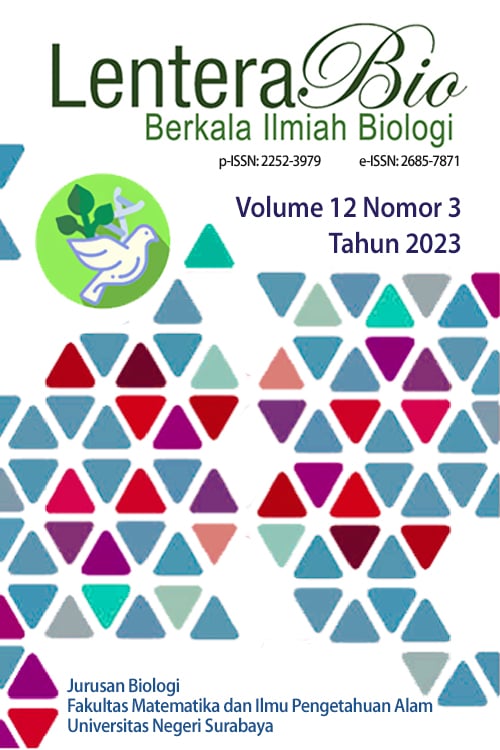Appropriation of Various Concentratons of Gibberellin on the Growth and Flowering Kenikir Plants (Cosmos sp.)
DOI:
https://doi.org/10.26740/lenterabio.v12n3.p396-404Keywords:
Cosmos sp., crop growth, gibberellin, flowering, growthAbstract
Kenikir plant, a vegetable in the Asteraceae family, is well-known in West Java. Kenikir (Cosmos sp.) serves various purposes, such as an herb, hedge, potential ornamental plant, natural food coloring, and in traditional ceremonial rituals. This study aimed to examine the impact of different gibberellin concentrations on kenikir's growth and flowering. It followed an experimental approach using the Randomized Block Design (RBD) method with five hormone concentration treatments: 0 ppm, 200 ppm, 400 ppm, 600 ppm, and 800 ppm, each repeated five times. Parameters measured included plant height, root length, plant wet biomass, stem diameter, flowering time, number of flowers, flower diameter, and wet biomass of flowers. Data were analyzed using One Way Anova and Duncan's test. Results revealed that varying gibberellin concentrations significantly influenced the growth and flowering of kenikir. The most optimal concentration for enhancing kenikir's growth and flowering was found to be 800 ppm, resulting in an average plant height of 121.00 cm, stem diameter of 1.20 cm, root length of 19.40 cm, plant wet biomass of 178.40 g, 156.80 flowers, 3.38 cm flower diameter, 14.86 g flower wet biomass, with an average flowering time of 41.2 days after planting (DAP).
Downloads
Published
How to Cite
Issue
Section
License
Copyright (c) 2023 LenteraBio : Berkala Ilmiah Biologi

This work is licensed under a Creative Commons Attribution-NonCommercial 4.0 International License.
Hak Cipta (c) LenteraBio: Berkala Ilmiah Biologi
Karya ini dilisensikan di bawah Lisensi Internasional Creative Commons Attribution-NonCommercial 4.0.
Pemberitahuan Hak Cipta.
Hak cipta dari artikel yang diterima untuk diterbitkan akan diberikan kepada jurnal sebagai penerbit jurnal. Hak cipta yang dimaksud meliputi hak untuk menerbitkan artikel dalam berbagai bentuk (termasuk cetak ulang). Jurnal mempertahankan hak penerbitan atas artikel yang diterbitkan.
 Abstract views: 999
,
Abstract views: 999
, PDF Downloads: 4935
PDF Downloads: 4935











